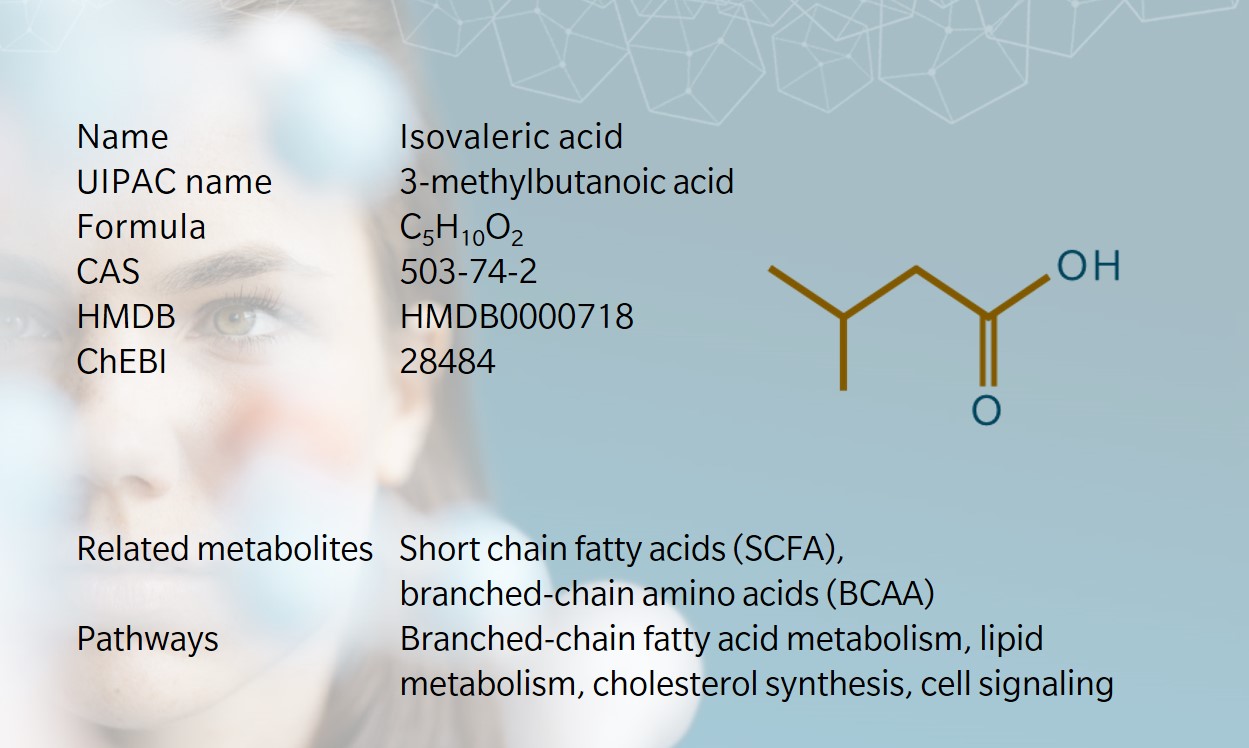- History & Evolution
- Biosynthesis vs. dietary uptake
- Isovaleric acid and the microbiome
- Isovaleric acid and branched-chain amino acids
- Isovaleric acid and digestive disorders
- Isovaleric acid and neurology
- Isovaleric acidemia
History & Evolution
c.1823: first discovered by Michel Eugène Chevreul (Dijkstra 2009) | 1860s: first investigation of chemical properties (Pedler 1868)
Isovaleric acid is one of several fatty acids discovered by Chevreul in the early 19th century (see also: butyric acid) (Dijkstra 2009). Originally named phocenic acid after its source, dolphin oil, isovaleric acid was later found in the valerian plant, and takes its contemporary name from there.
Isovaleric acid is a five-carbon branched short-chain fatty acid (BCFA). It’s an isomer of valeric acid and a conjugate of isovalerate. It smells of rancid cheese and is a common culprit of foot odor, though like butyric acid, its esters have a much more pleasant scent and are even used in perfumes (Budavari 1996, Ara et al. 2006). Traces are found in many plants, such as hops and tobacco, and in high-protein foods.
Isovaleric acid is associated with a rare condition known as isovaleric acidemia, which results in an excess of isovaleric acid metabolites in the blood.
Biosynthesis vs. dietary uptake
Isovaleric acid is produced in the colon by gut bacteria via fermentation of amino acids (i.e. leucine). It can also be absorbed from dietary sources. Dairy and beef products, apple juice, dry-cured meats, and fermented foods are all good sources.
It is often present in higher amounts as foods start to decay. Isovaleric acid is particularly common in beers and wines made with Brettanomyces yeasts. When beers are stored for long periods, these yeasts can ferment leucine and release isovaleric acid (Silva Ferreira et al. 2019).
While the major short-chain fatty acids (SCFAs) are released in the colon when gut bacteria ferment indigestible carbohydrates, BCFAs are produced in smaller amounts during the fermentation of proteins. For this reason, they may be seen as markers of protein fermentation (Ríos-Covián et al. 2020). High protein diets have been linked to higher concentrations of BCFAs (Aguirre et al. 2016).
Isovaleric acid is the product of leucine fermentation (Blakeney et al. 2019). The other branched-chain amino acids (BCAAs), valine and isoleucine, break down into the BCFAs isobutyric acid, 2-methylbutyric acid respectively.
Isovaleric acid and the microbiome
The behavior of gut microbiota during isovaleric acid production seems to be influenced by availability of amino acids, diet, metabolism, and microbiotic composition (Ríos-Covián et al. 2020).
Isovaleric acid is usually absorbed in the colon as a source of energy, or enters the bloodstream, where it then supports the regulation of fatty acid, glucose, and cholesterol metabolism (Niccolai et al. 2019). Accordingly, isovaleric acid is found in high amounts in feces and is a prominent fatty acid in the blood (Blakeney et al. 2019).
Straight-chain SCFAs and their role in human health have been more widely studied than isovaleric acid and the other BCFAs. In vitro studies show that BCFAs can protect against cancer, inflammation, and various metabolic disorders, though to date there haven’t been many human studies (Taormina et al. 2020).
Isovaleric acid and branched-chain amino acids
As noted, BCFAs are the products of BCAA degradation. They are usually one carbon shorter than their BCAA precursors, following oxidative decarboxylation from the keto acids to isoacids (Becht 1987). Intestinal amino-fermenting microbiota include Clostridium (Smith et. al. 1998) and Bacteroides (Aguirre et al. 2016) .
Another study of gut contents in recently deceased individuals showed that BCFA production was higher in the distal colon compared to the proximal colon (Macfarlane et al. 1992), revealing that amino acid fermentation increases as food progresses in the colon. Given that most diseases of the large intestine occur in the distal colon (Macfarlane et al. 1991), this suggests a relevance of amino acid fermentation for a broad array of gastrointestinal diseases (as reviewed by Macfarlane et al. 2012).
Isovaleric acid and digestive disorders
SCFAs are known to affect digestive health and may even act as potential biomarkers for bowel disease. Evidence is less robust for the BCFA subset. A case-control study compared the amount of SCFAs in feces in individuals with and without irritable bowel syndrome (IBS). Although there were statistically significant differences in fecal SCFA levels between the two groups overall, and particularly for butyric acid, isovaleric acid on its own did not appear to be a robust diagnostic tool (Farup et al. 2016).
However, one animal study showed that isovaleric acid activates protein kinase A (PKA) signaling in the colon, resulting in the relaxation of smooth colon muscle cells. This indicates that BCFAs do play some role in colonic health and motility (Blakeney et al. 2019).
Isovaleric acid and neurology
The gut-brain axis is of growing interest in neurology. Concentration of BCFAs in the gut have been linked to depression and anorexia nervosa (Szczesniak 2016, Mack 2016). Microbiota are thought to influence depression through inflammation, the hypothalamic-pituitary-adrenal (HPA) axis, and neurotransmitters (Foster et al. 2013).
One study showed a significant and direct correlation between isovaleric acid and depression, and between isovaleric acid and cortisol levels. While it is possible that lifestyle factors arising from depression and stress could disrupt the gut microbiome, the study found that another volatile fatty acid, isobutyric acid, did not show the same correlation with depression and cortisol as isovaleric acid.
This appears to confirm the influence of isovaleric acid and rule out significant lifestyle effects. The fact that creatine can be used to block isovaleric acid also suggests that isovaleric acid interferes with neurotransmission in the brain. Further studies might look at how dietary leucine affects this process (Szczesniak et al. 2016).
Isovaleric acidemia
Too much isovaleric acid in the blood is a sign of isovaleric acidemia, a rare, inherited metabolic disorder that can cause acidosis, vomiting, lethargy and a strong body odor, which usually presents soon after birth or in early childhood (Vockley et al. 2006). It is caused by a deficiency in the mitochondrial enzyme isovaleryl-CoA dehydrogenase (IVD), which helps break down isovaleric acid.
Without enough IVD, isovaleric acid builds up in the blood, preventing leucine metabolism. This is usually detected using mass spectometry. It can be treated with a low-protein diet, and carnitine and glycine supplements.
Learn more about the roles of isovaleric acid and other SCFAs in complex chronic diseases such as cancer, Alzheimer’s disease, depression, inflammatory bowel disease, multiple sclerosis and diabetes in our whitepaper “Complex chronic diseases have a common origin”.
References
Aguirre, M. et al.: Diet drives quick changes in the metabolic activity and composition of human gut microbiota in a validated in vitro gut model. (2016) Research in Microbiology | https://doi.org/10.1016/j.resmic.2015.09.006
Ara, K. et al.: Foot odor due to microbial metabolism and its control. (2006) Canadian Journal of Microbiology | https://doi.org/10.1139/w05-130
Becht, R.: Effects of Isoacids on Ruminal Metabolism and Milk Production. (1987) Iowa State University Veterinarian | https://lib.dr.iastate.edu/iowastate_veterinarian/vol49/iss1/3
Blakeney, B. et al.: The Branched Short Chain Fatty Acid Isovaleric Acid Causes Colonic Smooth Muscle Relaxation via cAMP/PKA Pathway. (2019) Digestive Diseases and Science | https://doi.org/10.1007/s10620-018-5417-5
Budavari, S. (ed.), ed. 1996. The Merck Index – An Encyclopedia of Chemicals, Drugs, and Biologicals. Whitehouse Station, NJ: Merck and Co., Inc.
Dijkstra, A.: How Chevreul (1786-1889) based his conclusions on his analytical results. (2009) OCL – Oilseeds and Fats, Crops and Lipids | https://doi.org/10.1051/ocl.2009.0239
Farup, P. et al.: Faecal short-chain fatty acids – a diagnostic biomarker for irritable bowel syndrome? (2016) BMC Gastroenterology | https://doi.org/10.1186/s12876-016-0446-z
Foster, J. et al.: Gut-brain axis: how the microbiome influences anxiety and depression. (2013) Trends in Neuroscience | https://doi.org/10.1016/j.tins.2013.01.005
Macfarlane, G.T. et al.: Composition and Metabolic Activities of Bacterial Biofilms Colonizing Food Residues in the Human Gut (1991) The Large Intestine, Physiology, Pathophysiology, and Disease | https://doi.org/10.1128/AEM.00754-06
Macfarlane, G.T. et al.: Comparison of fermentation reactions in different regions of the human colon (1992) Journal of Applied Bacteriology | https://doi.org/10.1111/j.1365-2672.1992.tb04882.x
Macfarlane, G. T. et al.: Bacteria, Colonic Fermentation, and Gastrointestinal Health. (2012) Journal of AOAC INTERNATIONAL | https://doi.org/10.5740/jaoacint.SGE_Macfarlane
Mack, I. et al.: Weight gain in anorexia nervosa does not ameliorate the faecal microbiota, branched chain fatty acid profiles and gastrointestinal complaints. (2016) Scientific Reports | https://doi.org/10.1038/srep26752
Niccolai, E. et al.: Evaluation and comparison of short chain fatty acids composition in gut diseases. (2019) World J Gastroenterol | https://doi.org/10.3748/wjg.v25.i36.5543
Pedler, A.: On the isomeric forms of valeric acid. (1868) | https://doi.org/10.1039/js8682100074
Ríos-Covián, D. et al.: An Overview on Fecal Branched Short-Chain Fatty Acids Along Human Life and as Related With Body Mass Index: Associated Dietary and Anthropometric Factors. (2020) Frontiers in Microbiology | https://doi.org/10.3389/fmicb.2020.00973
Silva Ferreira, C. et al.: Why Craft Brewers Should Be Advised to Use Bottle Refermentation to Improve Late-Hopped Beer Stability. (2019) Beverages 39 | https://doi.org/10.3390/beverages5020039
Smith, E. et al.: Enumeration of amino acid fermenting bacteria in the human large intestine: effects of pH and starch on peptide metabolism and dissimilation of amino acids.(1998) FEMS Microbiology Ecology | https://doi.org/10.1111/j.1574-6941.1998.tb00487.x
Szczesniak, O. et al.: “Isovaleric acid in stool correlates with human depression. (2016) Nutritional Neuroscience | https://doi.org/10.1179/1476830515Y.0000000007
Taormina, V. et al.: Branched-Chain Fatty Acids-An Underexplored Class of Dairy-Derived Fatty Acids. (2020) nutrients | https://doi.org/10.3390/nu12092875
Trautmann, A. et al.: Short-Chain Fatty Acids Modulate Metabolic Pathways and Membrane Lipids in Prevotella bryantii B14. (2020) Proteomes | https://doi.org/10.3390/proteomes8040028
Vockley, J. et al.: Isovaleric Acidemia: New Aspects of Genetic and Phenotypic Heterogeneity (2006) American Journal of medical genetics | https://doi.org/10.1002/ajmg.c.30089



